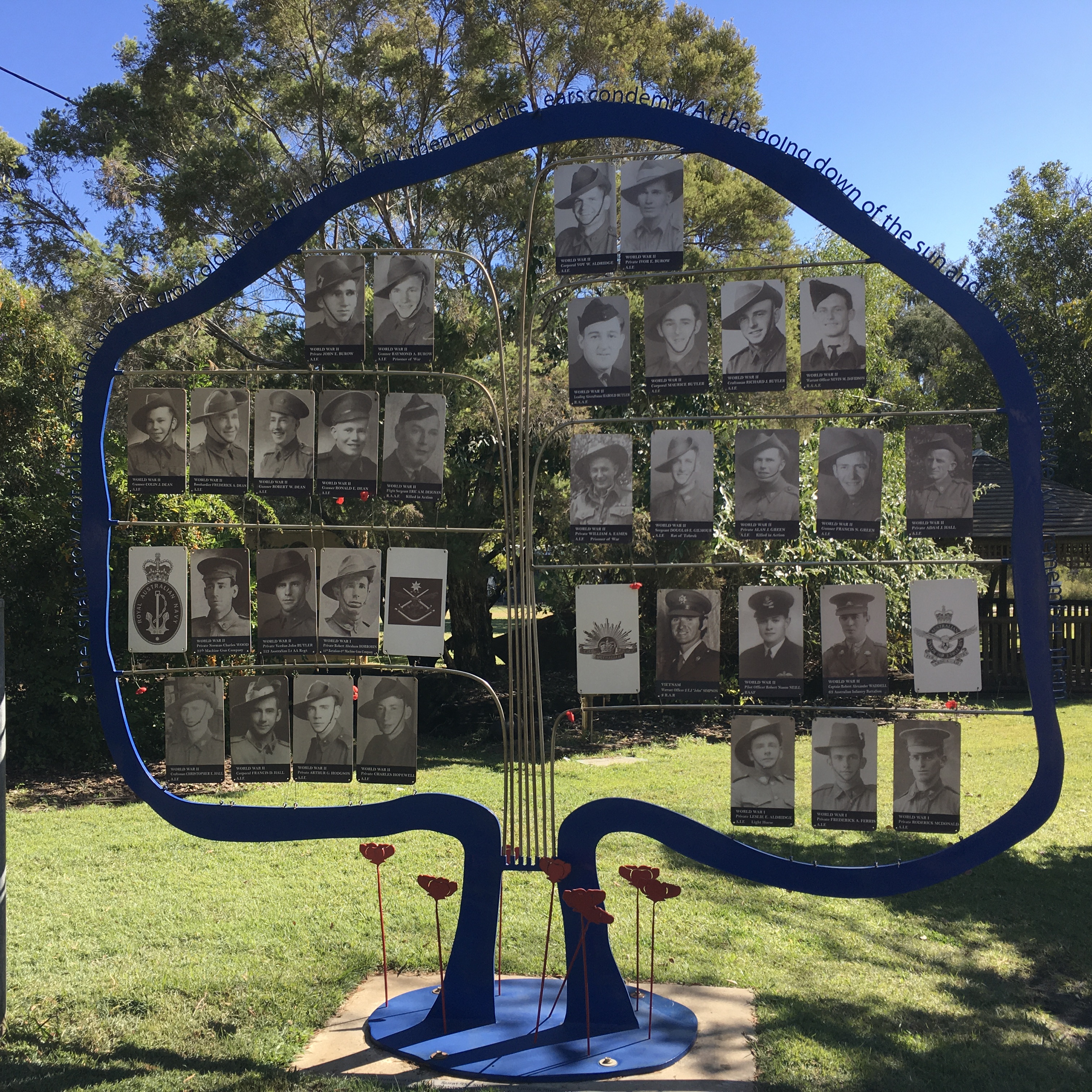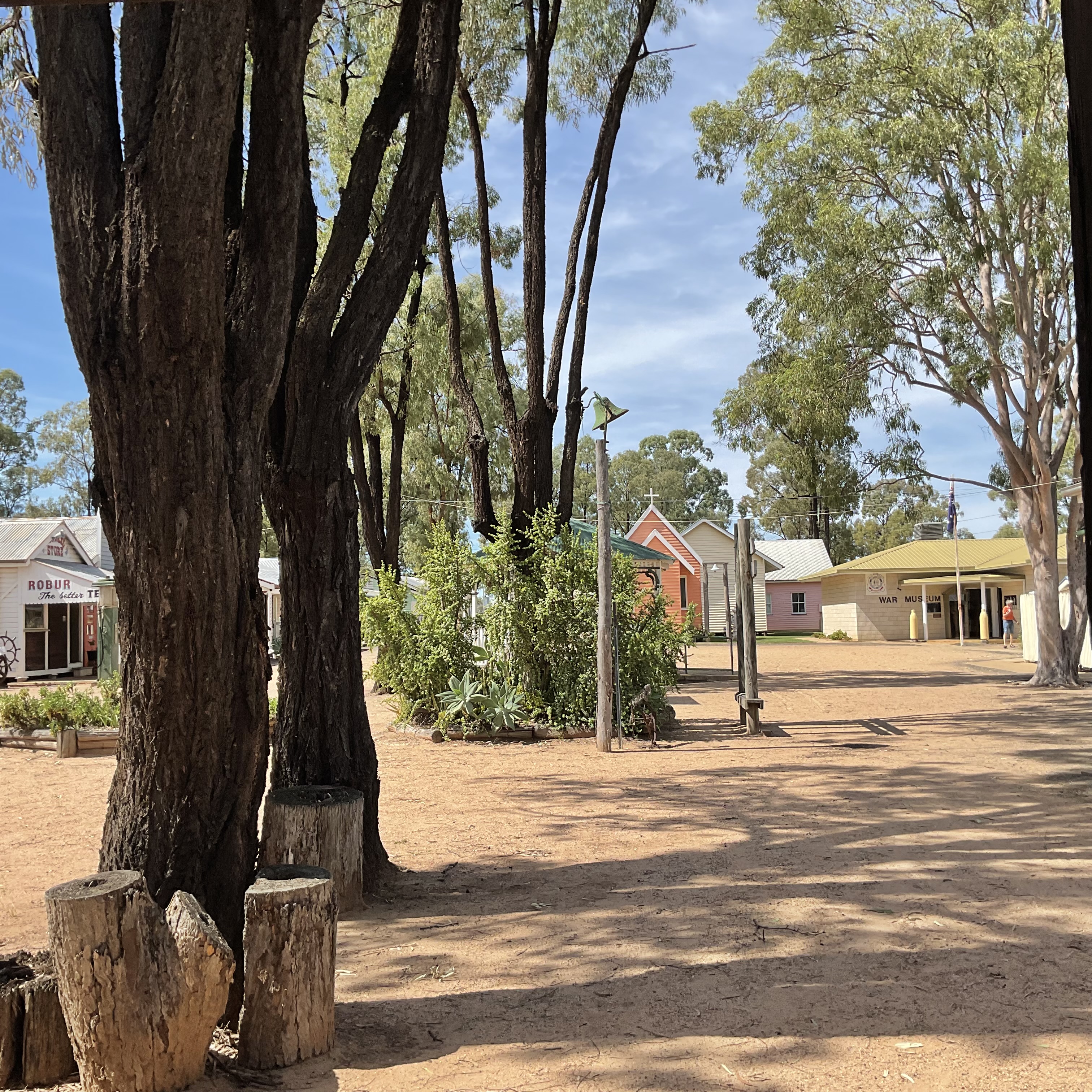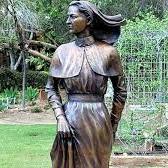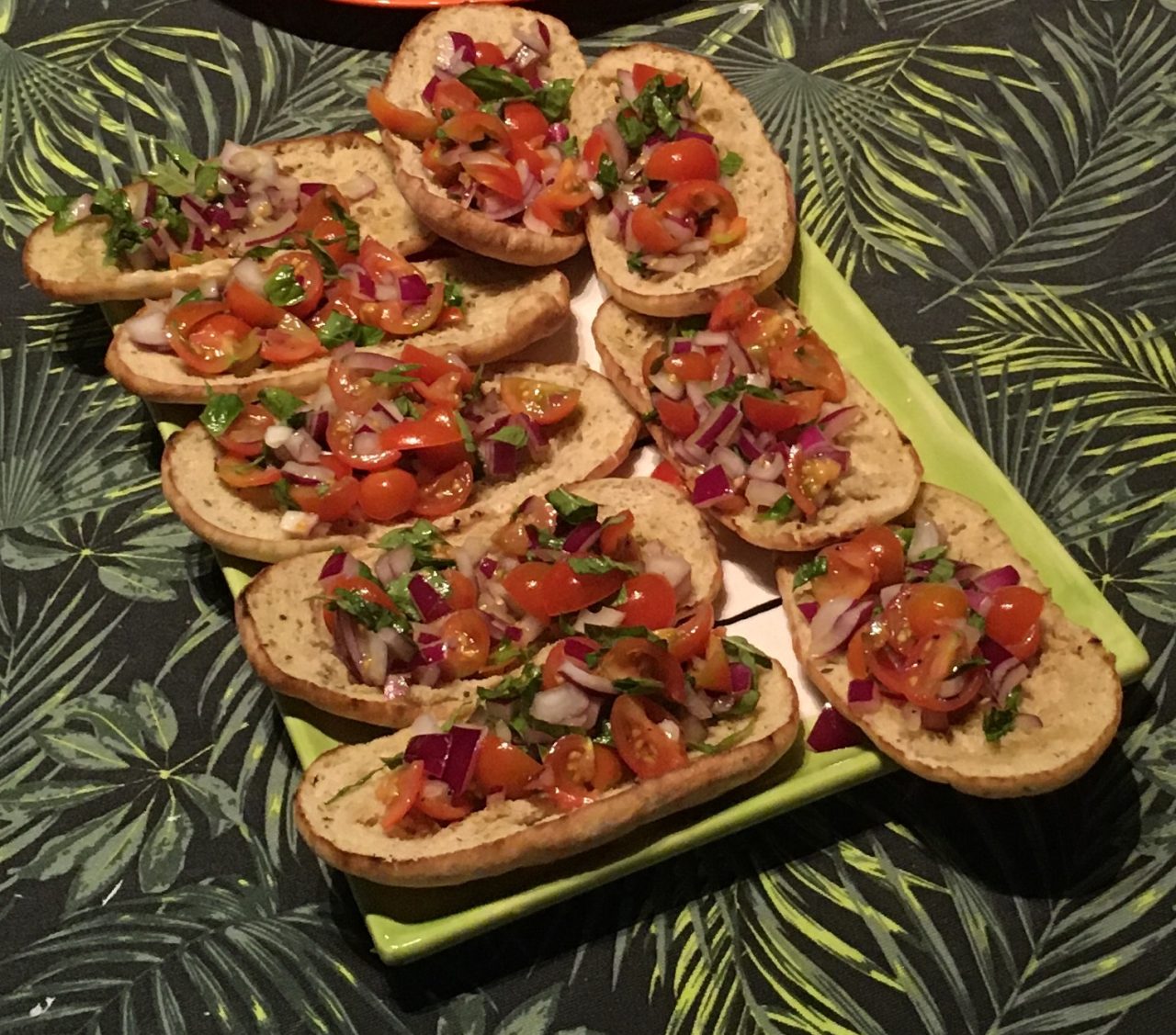Yesterday was ANZAC Day in Australia, a day during which the nation commemorates the victims of war and recognises the role of our armed forces. The day commences with a Dawn Service at the local cenotaph to remember the ill-fated campaign where Allied troops landed on the narrow beaches of the Gallipoli peninsula during WW1. This is generally followed by a march past, followed by lunch and other “festivities.”
Cleveland, Qld

Australian regional memorials have long been at the heart of community commemoration of our servicemen and women.
When driving through most Australian towns, large or small, you can almost always find a war memorial, often at the town centre. They come in the form of granite obelisks, memorial gates, statues and more. They are found in parks, hospitals, post offices, swimming pools and halls. They include honour rolls found in bowling clubs, schools, town halls and other community buildings. Statues of mostly First World War soldiers, known as ‘Digger memorials’, are also a distinctive feature in regional towns.
Surat, Qld

There is a website collating these memorials in Australia. Go here : https://placesofpride.awm.gov.au/memorials
I admit to being a total sucker for our country towns. Their buildings, cemeteries, museums and war memorials offer so much more in the way of history than anything printed in the travel brochures or offered at Tourist Information Centres.
During a short road trip last week to see the Dingo Fence, and bonus find the Rabbit Fence which I will share another time, we visited the Miles Historical Village on the Western Downs. Of particular interest was the War Museum loaded with local information pertinent to Miles in which I learnt that the Americans during WW2 established six artillery storage facilities near Miles, one being a current mine site which on occasion has unearthed refuse artillery.

Oh, how this kind of useless information fuels my soul……

It must be an age thing but for the first time in twenty years I was unable to crawl out of bed at 4am to greet the dawn. I set the alarm alright, but just couldn’t face it. Instead, I listened to Vera Lynn for the day and read an article about a newly erected monument in rural Blackall, Queensland, of WW1 nurse Sister Greta Norman Towner, “as a reminder of the significant contribution Australian women in service have made to the nation.” Interestingly, this monument stands in the park opposite the statue of her brother Lieutenant Edgar Thomas Towner, VC MC.

And for those Aussie readers with a few free hours on their hands the AWM is calling for volunteers to help preserve war diaries and records within their collection by transcribing. It’s easy and I failed typing in a business course. Go here:https://transcribe.awm.gov.au/

#A-ZChallenge 2024
Australian Trivia

We celebrate our soldiers and war heroes on November 11, a day we call Remembrance Day. Wasn’t WWII supposed to the the last one? I don’t think we’ve stopped fighting since.
LikeLike
We also celebrate Remembrance Day. ANZAC Day commemorates Australian and New Zealand Army Corps. Yes, you are right – the fighting never seems to stop…..
Have a beaut day, Susanne. I’m stuck with X……
LikeLiked by 1 person
I sort of cheated. You’ll see when we get to X Writer’s prerogative.
LikeLiked by 1 person
Hahaha. Thank you for today’s laugh.😂
LikeLiked by 1 person
You’re most welcome.
LikeLike
On our ship we had an ANZAC service at 6.00 am so I only had to get up at 5.30. Most of the Aussies and NZs turned up on the grassed area on the top of the ship and one of the ship’s band played the Last Post. There were Vietnam vets with their medals. I remember as a high school student listening to a vet from WW1! How time travels!
LikeLiked by 2 people
Linda, I remember my Dad not allowing me to date Vietnam Vets because they were too wild! Yes, the days pass quickly..l.
LikeLike
Today is the 25th for us, so please pardon the tardiness.
LikeLiked by 1 person
Not a problem, GP. I’m still disappointed that I didn’t make it to a Dawn Service. They are such a powerful yet emotional event.
To appease my guilt I am undertaking a couple of projects to assist preserve our military history : as a volunteer transcriber for the AWM, and assisting with research into the Battle of Crete by wading through old records for an author.
I’ll be better prepared next year! 8 hours of Vera Lynn knocked me about.
Have a beaut day. Cheers🥂
LikeLiked by 1 person
Special post, thanks for sharing.
LikeLiked by 1 person
Thank you for dropping by:)
LikeLiked by 1 person
Good morning Brizzy May,
I just read your very informative blog on W for war and museums and thought you may be interested in this article (that I had roughly translated), written for a Japanese newspaper by my son-in-law, Taka. Like you, he loves writing about anything and everything that piques his interest. Diana ??
[https://b2786218.smushcdn.com/2786218/wp-content/uploads/2023/12/PHOT2401.jpg?lossy=2&strip=1&webp=1] This mural features bright red poppies blooming under the setting sun. It is located at a nearby War Memorial, the same place that I mentioned earlier in this series when I mentioned Anzac Day and wrote things like “If you join Australia, obey Australia.”
November 11th every year is Remembrance Day. Literally, it is the anniversary of the end of World War I, a memory that must never be forgotten, and in most of the countries that participated in the war, even after 105 years, it is still a day of remembrance every year to pray for the soldiers who died on the battlefield. As this day approaches, you will begin to see red poppies in various places.
Red poppies used to be the first to bloom in the wilderness after battles in Europe, so they came to be treated as a symbol of the war dead, but their existence as a symbol was established by a Canadian poet who served in the war. It is said to be based on John MacRae’s poem “In the Fields of Flanders”. A line from McRae’s poem is also displayed on a panel next to the mural in the photo.
In World War I, Japan and Australia fought together as friends. Honestly, the reality is that Japanese residents in Australia do not know much about the fact that the Anzacs were sent to Gallipoli by a convoy guarded by the Imperial Navy cruiser HMS Ibuki. A Japanese woman I know told me that on November 11th, a colleague who put a poppy on her chest laughed and said, “That flower decoration is very pretty,” and to be honest, I couldn’t help but laugh as well. It goes without saying that if you don’t know something, you need to make an effort to find out.
I feel like it’s a bit clumsy to end with the same ending as I did on Anzac Day, but I’ll write it again. If you move to Australia, follow Australia. If you keep that in mind, you can’t go wrong.
[????(????)]????(????) Taka Uematsu (Hisataka Uematsu) Writer, columnist. As a special correspondent for the Japan-Australia Press living in Brisbane, he has long provided information on sports, mainly football, and QLD, mainly Brisbane. A Fukuoka native who has lived in Australia for over 20 years and has a secret mission to further promote Brisbane in the lead-up to the 2032 Brisbane Olympics.
Get Outlook for Androidhttps://aka.ms/AAb9ysg ________________________________
LikeLiked by 1 person
Young Taka must be a deep thinking fella. Who was aware that the ANZACS were sent to Gallipoli by a convoy guarded by the Imperial Navy cruiser HMS Ibuki? Shouldn’t we share this kind of information to promote unity and perhaps prevent future wars?
When Josie was in Primary School she was selected from all of Brisbane to give a speech on the steps of ANZAC Square under the Eternal Flame to commemorate the anniversary of the Rats of Tobruk. This ten year old girl had books from the library researching the events for days. In her
speech in front of thousands of family members of the Rats Jo included how the Polish soldiers had helped the Australians at Tobruk. She was applauded for sharing information that had not been put forward previously and was made a temporary Rat of Tobruk. She was adopted by the Rats and they took my ten year old away for a Rats luncheon at the Exservicemens Club in the city. It wasn’t just the Aussies and that needs to be remembered.
Thank you for sharing, and pat on the back to Taka.💐
LikeLike
The army was my Dad’s religion, he made a daily visit to the temple, the local RSL (Returned Soldiers League) Club each afternoon for a tipple with his mates.
ANZAC Day was the holiest of holies when he donned his war medals and went into Sydney to participate in the huge ANZAC day March that wound its way through the city. Dad’s proudest day was when he was up in the Sydney march holding the banner for his beloved 2nd/7th Field Regiment.
He also participated in the local march that was held on the Sunday closest to ANZAC Day. Mum, as a member of the Women’s Auxiliary, would be back at the club with the other ladies preparing a breakfast of bacon and eggs for then men who had marched,
I spent part of yesterday transcribing a local chap’s letter from a Trove newspaper article. He had written about his experiences on 25 April 1915 where he suffered three injuries before being shipped out.
LikeLiked by 1 person
Everyone has a story, don’t they? My Dad didn’t discuss the war, refused to join the RSL, and never marched. But he did insist I watch the Dawn Service in Martin Place with him from a very early age.
I too transcribe newspaper items from Trove about exservicemen from WW1. The articles often mention shellshock which brings the reality close to home. My first job was with the Repat Dept in York St, Sydney with one role being visits to Callan Park Hospital ( now Rozelle) on Welfare visits to vets.
LikeLiked by 1 person
So many veterans took their stories to the grave. Such a sad state of affairs.
LikeLiked by 1 person
Watch this space..
LikeLiked by 1 person
Yes always a big emotional day. Lovely to see how the schools all embrace the ceremonies encouraging the students to be involved
LikeLike
Yes. It truly is.🥲
LikeLiked by 1 person
Fascinating!
LikeLiked by 1 person
Battled with this one, but memorials honouring our dead tell you so much about the fabric of a township. I love the history. Thank you for reading.
LikeLike
Because I watched the Great Australian Bake Off, I made Anzac cookies once. They were tasty although I probably undercooked them, not being a fan of crunchy cookies.
LikeLiked by 1 person
I love the crunchy cookies. Makes them good for dunking!
LikeLike